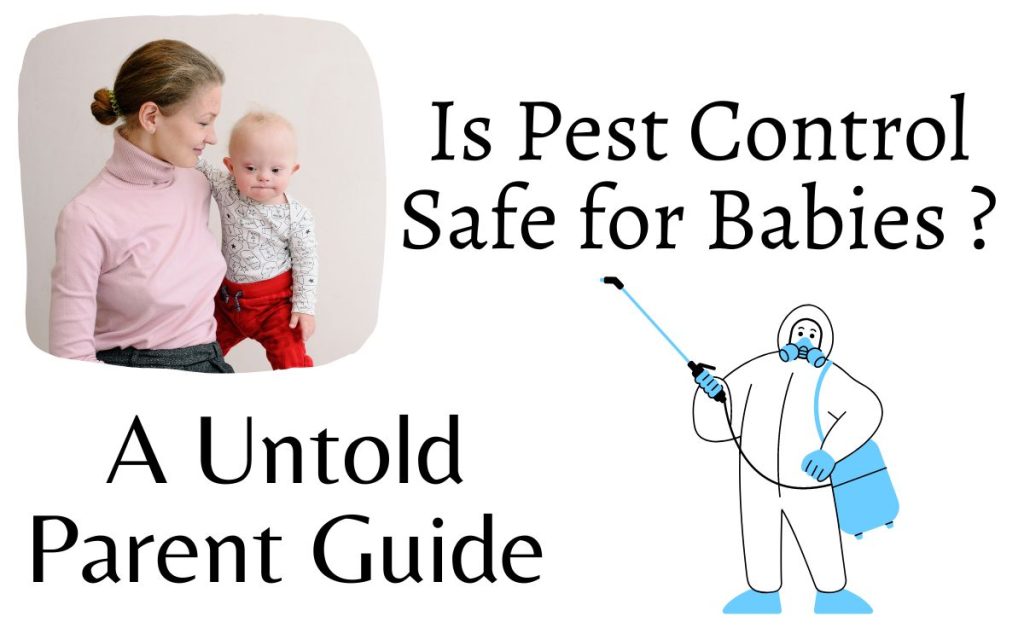Is pest control safe for babies? This question is of utmost importance for parents when considering pest control methods for their homes. Pest control involves managing, reducing, or eliminating unwanted creatures such as insects, rodents, and other organisms that pose a threat to human health, property, or the environment.
This article will explore the question “Is pest control safe for babies?” and guide parents through the various aspects of pest control, including prevention, detection, and treatment options, while offering practical tips for creating a pest-free and baby-safe home.
The article is going to be a little long. But I promise it’s important to know all of the aspects in this article. I hope this article will help you to take care of your baby and yourself as well.
Effective pest control is crucial for maintaining a healthy living environment, as pests can carry diseases, trigger allergies, and cause damage to homes and belongings.
However, parents must weigh the benefits of pest control against potential risks to their babies. Babies have weaker immune systems and are more susceptible to the adverse effects of chemicals and toxins.
Additionally, their curious nature and tendency to explore their surroundings by touching and tasting objects put them at a higher risk of exposure to potentially harmful substances.
As a result, parents need to carefully evaluate the pest control methods they employ in their homes to ensure they do not jeopardize the health and well-being of their little ones.
Is Pest Control Safe for Babies?
Pest control can be safe for babies if proper precautions are taken and the right methods are used. There are various pest control approaches, including chemical, biological, and physical control methods. To ensure the safety of babies and young children, it is recommended to use non-toxic, eco-friendly, and natural pest control methods when possible.
When using chemical pest control, opt for products with low toxicity levels and follow the instructions carefully. Keep babies and children away from treated areas until the recommended time has elapsed, and the area is well-ventilated. Store pesticides and other chemicals in a locked cabinet, out of reach of children.
Biological pest control, which relies on natural predators to control pests, is considered safe for babies. However, it’s essential to research the specific predator species and ensure they don’t pose a threat to your child.
Physical pest control methods, like traps and barriers, are generally safe, but they should be placed in areas where children can’t access them.
To ensure the utmost safety, consider hiring a professional pest control company with experience in child-safe treatments. Always communicate your concerns about the safety of your baby, so they can tailor their approach accordingly.
Things Parents Need to Know About Pests and Pest Control
Common Household Pests and Their Dangers
In our quest to answer the question, “Is pest control safe for babies?”, it’s important to first understand the common household pests, their characteristics, and the dangers they pose. This knowledge will help parents make informed decisions about pest control methods and ensure a safe living environment for their babies.
Types of pests and their characteristics
- Insects: These include pesky creatures like ants, cockroaches, flies, mosquitoes, and bed bugs. Insects are notoriously difficult to control because of their ability to reproduce rapidly and their constant search for food, water, and shelter.
- Rodents: Rats and mice are common household pests that can wreak havoc on our homes. With their strong teeth and constant need to chew, they can cause extensive damage to materials and food sources. Additionally, rodents can transmit dangerous diseases through their urine and droppings.
- Spiders: While some people may enjoy the occasional spider sighting, others may find them terrifying. Some species of spiders can bite and cause allergic reactions, making them a potential danger to our little ones.
You can read this article to know little more about it: https://agr.mt.gov/Pests/
Or you can watch the video
Diseases and health issues caused by pests
- Insects: Mosquitoes and ticks are well-known carriers of dangerous diseases like malaria, dengue fever, and Lyme disease. Additionally, pests like cockroaches and flies can contaminate food sources, leading to nasty illnesses like salmonella and E. coli infections.
- Rodents: Rats and mice can spread diseases like hantavirus and salmonellosis through their urine, droppings, and saliva. They can also carry fleas and ticks that can spread other diseases to humans.
- Spiders: While not all spiders are venomous, some species like the black widow and brown recluse can cause serious health complications if they bite.
Here you can know more about it: https://www.epa.gov/pesticides/public-health-issues-caused-pests
You can watch the video,
Property damage caused by pests
- Insects: Termites and carpenter ants can cause extensive structural damage to homes by feeding on wood. Other insects like silverfish and moths can damage clothing, books, and other personal belongings.
- Rodents: Rats and mice have a constant need to chew, and as such, can cause significant damage to materials like electrical wires, insulation, and food supplies. They can also contaminate living spaces with their urine and droppings.
- Spiders: While spiders don’t generally cause property damage, their webs can create an unsightly mess in homes, making them a nuisance to deal with.
I have a detailed reference from Forbes here. You must need to explore it :https://www.forbes.com/home-improvement/features/pest-control-survey-structural-damage/
By understanding the characteristics and dangers of common household pests, parents can make informed decisions about pest control methods that are safe for their babies.
Prevention and Early Detection of Pest Infestations
In this section, we’ll explore the signs of pest infestations, routine inspection practices, and preventive measures for common pests.
Signs of pest infestations
- Visual signs: Keep an eye out for droppings, shed skin, or eggs in your living spaces. These can indicate the presence of pests like rodents, insects, or spiders.
- Strange noises: If you hear scratching, rustling, or scurrying sounds coming from your walls or ceilings, it may be a sign of a pest infestation.
- Unusual smells: Foul odors like urine, feces, or rotting materials can indicate the presence of pests like rodents or insects.
Watch the video for better understandings,
Routine inspection practices
- Regular cleaning: Keeping your living spaces clean and tidy can go a long way in preventing pest infestations. Regularly clean your floors, countertops, and appliances to eliminate food and water sources for pests.
- Seal cracks and gaps: Pests can enter your home through small cracks and gaps in walls, floors, and ceilings. Seal these openings with caulk or other sealants to prevent pests from entering.
- Inspect your home: Regularly inspect your home for signs of pest infestations. Check for droppings, damage to materials, or unusual smells.
Preventive measures for common pests
- Insects: Use natural insect repellents like lemon or peppermint essential oils to keep insects at bay. Keep your living spaces clean and dry to eliminate potential breeding grounds for insects.
- Rodents: Keep your food supplies in airtight containers and regularly clean up crumbs and spills to eliminate food sources for rodents. Seal off any openings in your home to prevent them from entering.
- Spiders: Regularly dust and vacuum your living spaces to eliminate spider webs and their food sources. Use natural spider repellents like vinegar or citrus sprays.
Better reference, check this out:https://www.epa.gov/safepestcontrol/dos-and-donts-pest-control
By following these preventive measures and regularly inspecting your living spaces for signs of pest infestations, parents can stay one step ahead of potential pest problems.
Pest Control Options for Parents
In this section, we’ll explore some of the most common pest control options for parents.
Chemical pest control
- Synthetic pesticides: Synthetic pesticides are chemical-based products that are designed to kill pests. While they can be effective, they also come with potential health risks for humans and pets. It’s essential to use these products according to the manufacturer’s instructions and keep children and pets away from treated areas.
- Natural pesticides: Natural pesticides use plant-based ingredients like essential oils or borax to repel or kill pests. These products are generally safer for humans and pets but may not be as effective as synthetic pesticides.
Biological pest control
Biological pest control involves using natural predators or parasites to control pest populations. This option is generally safe for humans and pets, but it may not be as effective for severe infestations.
Physical pest control
Physical pest control involves using non-toxic methods like traps, barriers, or heat treatments to control pest populations. This option is generally safe for humans and pets, but it may not be as effective for severe infestations.
Cultural pest control
Cultural pest control involves using preventive measures like proper sanitation and hygiene practices to prevent pest infestations. This option is generally safe for humans and pets but may not be as effective for severe infestations.
Integrated Pest Management (IPM)
Integrated Pest Management (IPM) is a comprehensive approach to pest control that involves combining multiple pest control methods. This option is generally safe for humans and pets and can be effective for severe infestations.
Pest-specific Treatment Safety for Babies
While there are various pest control options available, some pests require specific treatments that may pose additional risks to babies and young children. In this section, we’ll explore the safety measures and precautions that parents should take when treating common household pests like termites, bed bugs, and indoor pests.
Is Termite Treatment Safe for Babies?
Termites are a common pest that can cause severe property damage if left untreated. There are various termite treatment options available, but some may pose potential health risks to babies and young children.
Types of termite treatments: Some of the most common termite treatments include liquid termiticides, baits, and fumigation. Liquid termiticides involve applying a liquid product to the soil around the home’s foundation, while baits involve placing termite bait stations around the home. Fumigation involves sealing the home and applying a gas that kills termites.
Safety precautions and measures: It’s essential to follow the manufacturer’s instructions and take necessary precautions when using termite treatments. Parents should ensure that babies and young children are not present during the treatment and that treated areas are thoroughly ventilated before allowing children back into the home. It’s also essential to store and dispose of the products properly to prevent accidental exposure.
Is Bed Bug Treatment Safe for Babies?
Bed bugs are another common pest that can cause significant discomfort and disruption to a household. While bed bug treatments are generally safe, some may pose potential health risks to babies and young children.
Types of bed bug treatments: Some of the most common bed bug treatments include heat treatments, chemical treatments, and steam treatments. Heat treatments involve raising the temperature of the infested area to kill bed bugs, while chemical treatments involve using pesticides to eliminate bed bugs. Steam treatments involve using high-temperature steam to kill bed bugs.
Safety precautions and measures: When treating bed bugs, parents should ensure that babies and young children are not present during the treatment and that treated areas are thoroughly ventilated before allowing children back into the home. It’s also important to use bed bug treatments according to the manufacturer’s instructions and store and dispose of the products properly to prevent accidental exposure.
Are Indoor Pesticides and General Pest Control Safe for Babies?
Indoor pesticides and general pest control products are commonly used to control a variety of pests, including ants, cockroaches, and spiders. While these products are generally safe, they can pose potential health risks to babies and young children if used improperly.
Types of indoor pesticides: Some of the most common indoor pesticides include sprays, baits, and traps. Sprays involve applying a liquid product to targeted areas, while baits and traps involve placing pest attractants or poison in areas where pests are known to frequent.
Safety precautions and measures: When using indoor pesticides and general pest control products, parents should ensure that babies and young children are not present during the treatment and that treated areas are thoroughly ventilated before allowing children back into the home. It’s also essential to use these products according to the manufacturer’s instructions and store and dispose of the products properly to prevent accidental exposure.
How to Discourage Household Pests
Preventing pest infestations in your home can be achieved by taking proactive steps to discourage pests from entering and breeding in your living spaces. In this section, we’ll explore some effective methods for discouraging common household pests like ants, cockroaches, and rodents.
Proper sanitation and hygiene practices
Regular cleaning of living spaces: One of the most effective ways to discourage household pests is to maintain a clean living environment. This includes regular cleaning of floors, countertops, and other surfaces where crumbs and food debris can accumulate.
Food storage and waste management: Proper food storage is essential to prevent pest attraction. Foods should be stored in airtight containers and kept off the floor. Additionally, garbage and food waste should be promptly removed and disposed of in sealed containers outside of the home.
Elimination of pest breeding grounds: Pests like ants and cockroaches are attracted to moist environments, so it’s essential to fix any leaks or water damage promptly. Standing water should also be eliminated to prevent mosquito breeding.
Home maintenance and repairs
Sealing gaps and cracks: Gaps and cracks in the home’s foundation and walls provide entry points for pests. Sealing these openings with caulking or weatherstripping can help prevent pests from entering.
Proper ventilation: Proper ventilation is essential to discourage pests like rodents from entering the home. Ensuring that attics and crawl spaces are adequately ventilated can prevent moisture buildup and deter pest attraction.
Pest-proofing measures: Installing screens on doors and windows can prevent insects from entering the home, while door sweeps can prevent rodents from entering through gaps under doors. Additionally, using pet food dishes that are elevated off the floor can prevent pests from accessing the food.
By taking these proactive steps, you can discourage household pests from entering and breeding in your living spaces, which can help prevent infestations and keep your home and family safe.
Safe Pest Control Measures for Babies
When it comes to pest control, parents must take extra precautions to ensure the safety of their babies. In this section, we’ll explore some safe and effective pest control measures that parents can use to protect their homes from pests without putting their babies at risk.
Use of non-toxic and eco-friendly pest control methods
Biological control agents: These are natural predators that feed on pests and help control their populations. Examples include ladybugs, nematodes, and certain types of bacteria.
Physical barriers and traps: Using physical barriers like screens and door sweeps can prevent pests from entering the home, while traps can capture pests without using harmful chemicals.
Natural repellents: Certain plants like lavender and citronella can repel pests like mosquitoes and flies, while essential oils like peppermint and eucalyptus can repel ants and cockroaches.
Precautions during chemical pest control treatment
Proper ventilation: When using chemical pesticides, it’s essential to ensure proper ventilation to prevent the buildup of toxic fumes. Open windows and doors, and use fans to circulate the air.
Use of safety gear: When applying chemical pesticides, wear protective clothing like gloves, goggles, and respirators to prevent exposure.
Strict adherence to product label instructions: Follow the instructions on the product label carefully to ensure safe and effective use.
Safe storage of pesticides: Pesticides should be stored in their original containers, out of the reach of children and pets, and in a cool, dry place away from heat sources.
By using these safe and effective pest control measures, parents can protect their homes from pests without putting their babies at risk.
Some Age-Appropriate Ways to Teach Children About Pest Control and Safety
In this section, we’ll discuss some age-appropriate ways to teach children about pest control and safety.
Age-appropriate pest control education
Young children can learn about pests and pest control through books, songs, and simple activities like bug hunts and drawing. As they get older, they can learn about the dangers of pests and the different types of pest control methods.
Importance of personal hygiene and cleanliness
Teaching children about personal hygiene and cleanliness is an essential part of pest control and safety. Children should learn to wash their hands regularly, keep their living spaces clean, and dispose of food waste properly to prevent attracting pests.
Safe ways for children to participate in pest control activities
Children can participate in pest control activities by helping with cleaning and organizing, sealing gaps and cracks, and setting up traps. It’s essential to teach children how to handle pest control products safely and how to report any pest sightings to an adult.
By educating children about pest control and safety, parents can help them develop healthy habits and a sense of responsibility for maintaining a pest-free home.
Conclusion
By following the guidelines and recommendations in this article, parents can create a healthier and safer living environment for their babies and young children. Remember, the safety and well-being of our little ones should always be our top priority, and we must take all necessary steps to ensure their protection.
Michael C Vang is a passionate blogger. He has been blogging since 2013 on a variety of topics. He is committed to creating informative and engaging content that helps readers learn more about everything.



